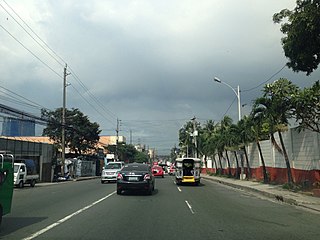
Quezon City, also known as the City of Quezon and Q.C., is the most populous city in the Philippines. According to the 2020 census, it has a population of 2,960,048 people. It was founded on October 12, 1939, and was named after Manuel L. Quezon, the second president of the Philippines.

San Pablo, officially the City of San Pablo, is a 1st class component city in the province of Laguna, Philippines. According to the 2020 census, it has a population of 285,348 people.

San Jose del Monte, officially the City of San Jose del Monte, is a 1st class component city in the province of Bulacan, Philippines. According to the 2020 census, it has a population of 651,813 people, making it the largest local government unit within the province of Bulacan and Central Luzon and the 18th most populated city in the Philippines. The City of San Jose del Monte had been proclaimed as a highly urbanized city on December 4, 2020, by the virtue of Proclamation No. 1057, signed by President Rodrigo Duterte and shall take effect after the ratification in a plebiscite.

Mandaluyong, officially the City of Mandaluyong, is a first class highly urbanized city in the National Capital Region of the Philippines. According to the 2020 census, it has a population of 425,758 people.

Pasig, officially the City of Pasig, is a highly urbanized city in the National Capital Region of the Philippines. According to the 2020 census, it has a population of 803,159 people.

Caloocan, officially the City of Caloocan, is a 1st class highly urbanized city in Metro Manila, Philippines. According to the 2020 census, it has a population of 1,661,584 people making it the fourth-most populous city in the Philippines.

Candelaria, officially the Municipality of Candelaria, is a 1st class municipality in the province of Quezon, Philippines. According to the 2020 census, it has a population of 137,881 people.

San Juan, officially the City of San Juan, is a 1st class highly urbanized city in the National Capital Region of the Philippines. According to the 2020 census, it has a population of 126,347 people. It is geographically located at Metro Manila's approximate center and is also the country's smallest city in terms of land area.

Siniloan, officially the Municipality of Siniloan, is a 2nd class municipality in the province of Laguna, Philippines. According to the 2020 census, it has a population of 39,460 people.

Gumaca, officially the Municipality of Gumaca, is a 1st class municipality in the province of Quezon, Philippines. According to the 2020 census, it has a population of 71,942 people.

San Jose, officially the Municipality of San Jose, is a 1st class municipality in the province of Batangas, Philippines. According to the 2020 census, it has a population of 79,868 people.

Mabini, officially the Municipality of Mabini, is a 3rd class municipality in the province of Pangasinan, Philippines. According to the 2020 census, it has a population of 26,454 people.

San Fernando, officially the City of San Fernando, is a 1st class component city and capital of the province of Pampanga, Philippines. According to the 2020 census, it has a population of 354,666 people.

Fernando Poe Jr. Avenue is the principal north–south tertiary road serving the San Francisco del Monte district of Quezon City, Philippines. It runs with a length of 2.871 kilometers (1.784 mi) between Epifanio de los Santos Avenue (EDSA) to the north and Quezon Avenue to the south. The avenue is named after Fernando Poe Jr., a renowned actor and National Artist of the Philippines. As Roosevelt Avenue, it was named after United States president Franklin D. Roosevelt.

Veterans Village, more commonly known as Project 7 and Muñoz, is a barangay located in Quezon City with an approximate land area of 51.941 hectares bounded by Barangay San Antonio in the Southwest, Roosevelt Avenue in the West, Barangay Bungad in the Southeast and EDSA in the North.

Santa Cruz often abbreviated as Sta. Cruz is a barangay located in the San Francisco Del Monte district of Quezon City with an approximate land area of 44 hectares bounded by South and West Triangles in the East, Quezon Avenue and Barangay Paligsahan in the South, Nayong Kanluran in the Northeast and Barangay Paltok in the North.

Bungad is an administrative division in eastern Metro Manila, the Philippines.

San Francisco del Monte, also referred to as SFDM, is a district of Quezon City, Metro Manila, the Philippines. It is bisected by two major thoroughfares, Fernando Poe Jr. Avenue and the eponymous Del Monte Avenue, and is bounded by Atty. Pat Senador Sr. Street and Baler Street to the north, and Judge Juan Luna Street, Paraiso Street, and Cooper Street to the east.

Mariana, is an administrative division in eastern Metro Manila, the Philippines. It is an urban barangay in Quezon City in a middle class residential and commercial area known as New Manila, which includes Barangay Mariana and the adjacent Barangay Damayang Lagi.

The Basilica Minore de San Pedro Bautista, also known as the San Francisco del Monte Church and alternatively as Santuario de San Pedro Bautista, is a minor basilica and parish church in the San Francisco del Monte district of Quezon City, Philippines. It is one of the oldest churches in the country and the oldest in the city, having been founded in 1590. The church is dedicated to its founder Padre Pedro Bautista, a Spanish missionary from Ávila, Spain, one of the 26 Christians martyred in Japan in 1597.
























